Land
10 major threats to Aboriginal land
Many threats endanger Aboriginal land and Aboriginal peoples' heritage, history and sacred sites—are you one of them?

Wishing you knew more about Aboriginal culture? Search no more.
Get key foundational knowledge about Aboriginal culture in a fun and engaging way.
This is no ordinary resource: It includes a fictional story, quizzes, crosswords and even a treasure hunt.
Stop feeling bad about not knowing. Make it fun to know better.
You'll be surprised how many threats endanger Aboriginal land. Indigenous people have to fight on many fronts to keep alive their heritage, history and sacred sites.
— Bev Manton, Chairperson New South Wales Aboriginal Land Council in 2010 [1]
Threat: Climate change
- 4.67mtrs
- Peak of a major king tide on Boigu Island in early 2011, Torres Strait [2]
- 4.43mtrs
- King tide peak at Poruma, Torres Strait [2]
- $22.4m
- Estimated cost to protect the Torres Strait islands from being flooded during high tides [3]
Climate change affects Aboriginal land already. Torres Strait Islanders are noticing visible changes to their land, including erosion, rough seas and higher storm frequency, according to former Aboriginal and Torres Strait Islander Social Justice Commissioner Tom Calma. [4] Other risks include flooded sacred sites, eroded and exposed burial sites, reduced crops, fewer fish, king tides, and ocean acidification and its effects on coral reefs and fish.
Extreme weather conditions have the potential to reduce water availability and erode infrastructure like sewerage systems and housing on the islands.
Many villages are only about 2 metres above sea level. Constructing sea walls and coastal erosion control measures can help some of the worst affected islands, [5] especially if they have airstrips, but it is not a long-term solution.
Map: On Iama (Yam) Island, Torres Strait, residents' homes are already frequently inundated with sea water [3]. The island could be lost to the sea if no conservation measures are taken.
The 2008 Garnaut Report identified the Torres Strait as especially vulnerable. Over the next century the sea-level is expected to rise by up to 59 centimetres [6].
"There is a real possibility that some communities will need to move to higher ground or relocate altogether to the mainland," Calma said. Shaun Edwards from far North Queensland agrees, predicting that "Torres Strait Islanders will end up coming to the mainland" [7], an option not considered by others such as Climate Change Minister Penny Wong [8].
Fred Gela, Mayor of the Torres Strait Island Regional Council, says that "the land and sea in the Torres Strait is a critical part of our spiritual and physical identity." [5] Inaction would put at risk the survival of their way of life which is unique in Australia.
But Aboriginal people are well-placed "to help mitigate the impacts of climate change because of where they live and their unique knowledge of the land," says Joe Ross, Chair of the Northern Australia Land and Water Taskforce [9].
We already have water rising in Kowanyama… At high tide water runs right through some islands.
— Shaun Edwards, Cape York Aboriginal leader [7]
On mainland Australia, some Aboriginal communities feel that global heating threatens their survival. Houses are not built to deal with prolonged periods of extreme heat and several outstations are running out of water or have poor drinking water quality.
Houses in town camps are often built from cheap, hollow concrete blocks which trap the heat. Without sufficient tree cover houses and overwhelmed air conditioning units, people sleep outside, in shifts or overcrowd the coolest room of the house – with often devastating consequences.
In Central Australia more than nine remote communities and outstations are
already experiencing water shortages as well as frequent and intense heatwaves. [10]
In some communities, such as Yuendumu, about 300 kms north-west of Alice Springs, the government is no longer building new houses because there isn’t enough water in the aquifer to accommodate more people. Most communities in the NT have either poor water quality, are water stressed, or experience both. [11]
Regional centres such as Alice Springs might need to brace for an influx of climate refugees from Australia's tropical north.
People will be forced to leave their country and leave behind much of what makes them Aboriginal. Climate change is a clear and present threat to the survival of our people and their culture.
— Josie Douglas, Manager of Policy and Research, Central Land Council [11]
In Alice Springs, the mean number of days in January with 40 °C or above between 1981 and 2010 was 7. In January 2019, there were 22 such days. [12]
Threat: Tourism
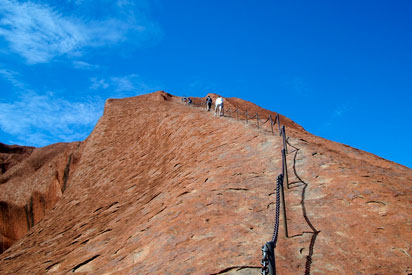
38% - Percentage of visitors who climbed Uluru in 2010; [13] in 2012: just over 20%; [14] in 1993: almost 75%. [15]
- 35
- People who have died climbing the rock. [16]
Tourism can often peacefully coexist with Aboriginal land, but sometimes is a threat to Indigenous interests. Uluru (formerly known as Ayers Rock) is one such example.
For Aboriginal people Uluru is a sacred site and should be off-limits for non-Indigenous visitors. Demands to close the only climb in respect to the rock's significance have been made many times.
Kunmanara Uluru, one of the traditional owners, says: "That's a really important sacred thing that you are climbing... You shouldn't climb. It's not the real thing about this place. The real thing is listening to everything. And maybe that makes you a bit sad. But anyway that's what we have to say. We are obliged by Tjukurrpa [Dreaming, Dreamtime] to say. And all the tourists will brighten up and say, 'Oh I see. This is the right way. This is the thing that's right. This is the proper way: no climbing'." [17]
But Uluru is an icon of international value for Australia's tourism industry. When yet another call for its closure was made in early 2010 the Prime Minister Kevin Rudd, NT Chief Minister Paul Henderson and Environment Minister Peter Garett were compelled to call for Uluru to be kept open because "the future for this internationally significant icon lies in visitor experiences that reflect its World Heritage values". [16]
Unfortunately some of Uluru's annual 100,000 visitors don't care much about its sacredness or the signs that discourage a climb and pee and defecate on it. [16][18] Many more party or urinate up there. Visitors from all over the world take home parts of the rock, and many feel haunted for months after, subsequently sending back their stones to Australia.
[Prime minister] Kevin Rudd won't be around forever. One day he'll be gone and Aboriginal people won't. They'll still be there watching people leave tracks over their sacred site.
— David Ross, director Central Land Council (representing Indigenous groups) [16]
What most people are unaware of is the fact that the heart centre of Australia – Uluru – has a calling of healing energy to the spirit to come, and experience 'The Rock'. This draws many, if not millions, from all over the world to touch, connect to and experience these vibrations of one of the most sacred heart centres of the earth.
— Pascoe Braun, son of one of the custodians of Uluru [19]
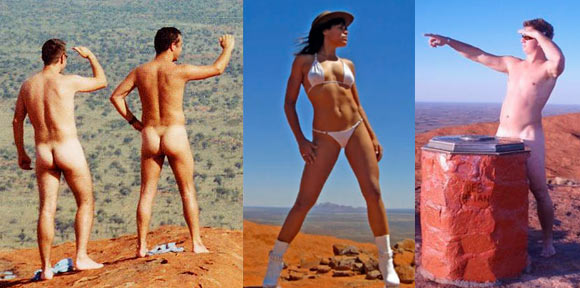
Threat: Sports
Delicate rock art sites, often not signposted to protect them, are vulnerable to climbers who step on the art, cover it with chalk or drill holes and bolts into the rock, traditional custodians claim. They also create paths through virgin bush to access climbing sites. [20] As a result, climbing has been banned in some areas, such as in parts of the Grampians National Park in Victoria.
Recreational and off-road vehicles used by tourists and locals can damage Aboriginal sites in conservation areas and national parks.
For example, the Arthur-Pieman Conservation Area in Tasmania, described as "one of the world's greatest archaeological regions" [21] for its Aboriginal heritage, has been subjected to damage for many years.
Most if not all tracks in the area go over Aboriginal heritage sites. Attempts to close tracks to prevent damage failed because "people have pulled [barriers] out and gone around them". [21] A strong vehicle lobby vetoes attempts to implement barriers.
Threat: Development
- $1m
- Maximum legislated fine in Tasmania for destroying historic European heritage. [22]
- $1,000
- Maximum legislated fine in Tasmania for destroying Aboriginal heritage. [22] The same fine before the introduction of the Aboriginal Heritage Act in 1988: $200. [23]
- $4,690
- Fine a court ordered electrical company Ausgrid pay in 2013 for destroying a significant rock engraving on Sydney’s north shore in late 2010. Maximum fine for a corporation available to the court: $220,000. [24]
Developers' projects such as infrastructure, businesses and dwellings often threaten to damage or destroy sacred sites, rock art or places of great important to the local Aboriginal people.
Sometimes Aboriginal artefacts make their way into fill used to fill excavated areas, [26] hundreds of kilometres away from the artefacts' home country.
Case studies
For example, in late 2009 the 'Guardian Tree' at Bulahdelah in New South Wales, "the most sacred site of the Worimi nation", was cut by workers with chainsaws, backed by police who kept the protesters away. [27] The tree made way for a highway bypass.
Similarly, about 3,000 trees were marked for destruction for an upgrade of the Western Highway in Victoria. Among them scar trees, birthing trees (one of them thought to be 800 years old) and other culturally modified treed. [28] The matter went to court where activists appealed the environment minister's decision to go ahead. [29]
Aboriginal people in Tasmania in 2009 fought the Brighton Bypass which was bulldozed through land rich of significant sites with an estimated 3 million artefacts and "one of the most important archaeological sites in Tasmania" according to head archaeologist Rob Paton. [30] It was confirmed to date back 40,000 years, making it the oldest site in the southern hemisphere with evidence of human habitation. [31] The government decided to build a bridge over the area despite two years of meetings, lobbying, court challenges to heritage legislation, an emergency national heritage listing, dozens of arrests and protests which even gained support of many of the workers employed to build the bridge. [32]
Two days before Christmas 2011 the site, also referred to as Kutalayna (Jordan River Levee), was placed on Australia's National Heritage List, [33] which puts it on the same level as Uluru and the Great Barrier Reef.
A Matter of Consequence
From time to time I sit and stare, observe this land that is now bare. Most proceed without thought or care for this spiritual sanctuary we're meant to share. More land is cleared new buildings raised, toxic waste dump proposals ensure an early grave. Silently the ghosts of millennia past refuse to submit to modernity's farce. They rise through the soil then into the air, seeking revenge for two centuries of despair. To politicians and others who've never been fair, I strongly suggest, beware, beware... The wrath of those spirits who live in the earth, those ancient guardians who lived here first. [34]
In June 2010 Gomilaroi Elder Lyall Munro was fighting the sale in Moree, NSW, of a site known to have been an Aboriginal burial ground. The NSW government had approved the sale to retailing giant Woolworths. Munro believes the remains of 39 people could still be in the site. [35]
When disputes between Aboriginal stakeholders involved in negotiations for a proposed multi-million-dollar gas hub near Broome, in Western Australia, took too long the Western Australian premier simply announced to compulsorily acquire the land. But instead of the 3,500 hectares under negotiation the government wanted to acquire 20,000 hectares for "some flexibility to identify final locations". [2]
Bev Manton, Chairperson of the NSW Aboriginal Land Council, observes that "some 900 sites have been destroyed in recent years… with recent figures showing up to five permits [to destroy cultural heritage] being issued a week". [1] New South Wales remains the only state without independent culture and heritage legislation.
The situation in Tasmania is similar. "We have found that since [Tasmanian] Minister [for Environment, Parks, Heritage and the Arts] Michelle O'Byrne took over responsibility for Aboriginal heritage, more than 30 destruction permits were issued under her name without any involvement of Aboriginal people," says Michael Mansell, Director of the Tasmanian Aboriginal Legal Centre. [30]
The need to preserve ancient buildings has never been more embedded in Tasmanian culture than it is today, yet there is the strange contradiction in attitudes towards preserving Aboriginal heritage.
— Michael Mansell, Aboriginal campaigner [36]
I find it astounding the [Tasmanian] government would push to build a four-lane freeway through the world's oldest known site of human inhabitation in the southern hemisphere, all in the name of saving a whopping eight minutes driving time.
— Bev Manton, Chairwoman, New South Wales Aboriginal Land Council [37]
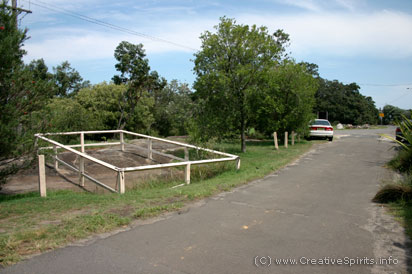
What can you do?
Excavation or destruction of registered sites is prohibited by law and fines apply. If you believe that there may be an area under threat that has cultural significance you can contact your local traditional owners (through an Aboriginal Land Council) or the a government department (for example in NSW the Aboriginal Heritage Office) and have the area investigated.
New South Wales is the only state or territory that hasn't enacted separate legislation for the protection of our precious culture and heritage. [38]
Nationally, Section 9 of the Aboriginal and Torres Strait Islander Heritage Protection Act 1984 empowers the Environment Minister to make an emergency declaration that, for 30 days, protects an Aboriginal site from injury or desecration. Section 10 allows to certify an area as designated Aboriginal site. [39]
Threat: Resources industry
- $80,000
- Fine for Xstrata Mount Isa Mines after the company pleaded guilty to damaging an Aboriginal cultural heritage site. Xstrata had bulldozed cultural heritage objects including flint spears and knives while upgrading a road. [40]
- $1,400
- Fine ordered by a court for knowingly destroying two ancient Aboriginal camp sites, despite the miner's expert identifying the sites. [41]
- 40
- Number of sites mining giant BHP planned to destroy in 2020 which had the approval of the Western Australian Aboriginal Affairs Minister. [42]
- 150
- Number of leaks, spills and licence breaches of the Ranger uranium mine in Kakadu National Park since it opened in 1981. [43]
40% - Percentage of the world's mineable high-grade uranium deposits which are located in Australia.
- 46,000
- Age of a site in the WA Pilbara region that was legally destroyed by mining giant Rio Tinto in 2020. [44]
- 35m
- Number of litres of Great Artesian Basin water BHP Billion's Olympic Dam mine uses every day, free of charge, the "largest industrial user of underground water in the southern hemisphere". [45]
- 36
- Number of sites mining companies excavated in Eastern Guruma country, WA, between 2010 and 2020. Of those, 25 were destroyed. There is no commitment to preserve the remaining sites. [42]
80% - Percentage of mining activities in Australia that take place on Aboriginal land. [46]
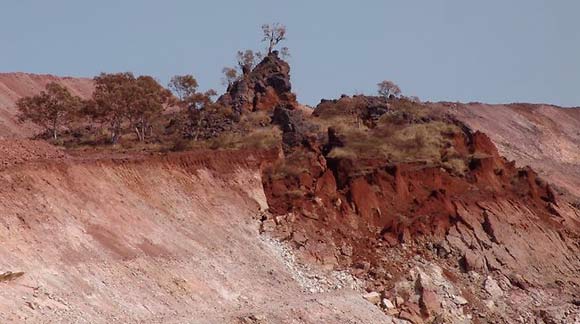
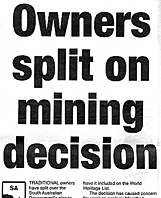
Mining interests collide with Aboriginal land interests ever since Australia's rich resources were discovered. 80% of mining activities in Australia take place on Aboriginal land. [46] And many political decisions are not driven by the best interests for Aboriginal people but by revenue generated by the resource industry or based on biased and inadequate legislation.
How else could you explain ministers allowing mining projects to go ahead despite acknowledging in the same breath that the sites they'll destroy "retain immeasurable cultural values and connection to country" to their Aboriginal custodians. [49]
Development pressure by the resources industry for many remaining wilderness areas is "extensive and imminent" [50] and it appears that the industry often uses "stand-over and divisive tactics" to pressure Aboriginal groups into entering deals [51] rather than consulting with them properly. "We speak, and no-one listens," is their common complaint. [42]
In 2020, New South Wales was the only state with no stand-alone Aboriginal heritage legislation. [52]
A 1977 act of Parliament allowed mining to go ahead on lands of the Mirarr people (north-western Northern Territory) without their express consent – despite the same act giving a right of veto to most of the nation's other Aboriginal groups. [53]
Mining companies undertake investigations to understand the importance of sites in exchange for the ability to then destroy them.
— Dr Kathryn Przywolnik, archaeologist and heritage manager at Wintawari Guruma Aboriginal Corporation [42]
Mining delivers... environmental disasters
Jillian Marsh is a member of the Australian Nuclear Free Alliance (ANFA) Committee and a custodian of the Adnyamathanha people of the Flinders Ranges in South Australia.
She says that "extensive case study research and the concerns raised by Aboriginal people at the grass-roots level shows that mining agreements have not improved life for Aboriginal people, and uranium mines mean more problems."
"It is cynical for the uranium industry to act as if it can deliver for Aboriginal people. The main lasting effect of uranium mining for Aboriginal people is radioactive waste on their country, and no resources to clean up the mess left by miners". [54]
Toro Energy’s Wiluna project, which was given the go-ahead in April 2013, projected to store 9.1 million cubic metres of radioactive mine waste in a lake bed. [55]
In December 2013, a leach tank burst at the Ranger uranium mine, located in the Kakadu National Park in the Northern Territory, spilling 1 million litres of highly acidic uranium slurry that engulfed the mine and breached containment lines [56], a spill considered "one of the worst uranium disasters in Australian history". [57]
Ranger has experienced more than 200 spills, leaks and breaches since opening in 1979. [56]Communities surrounding nuclear mines and bombs sites have noticed cancer clusters, increased health problems such as diabetes, kidney failure and ill health. [58]
High levels of the lethal crocidolite asbestos from asbestos dust exposure in the mine in Wittenoon, 1,100 kilometres north-north-east of Perth, WA, affects Aboriginal people in both their homes and on sacred sites, causing mesothelioma. [59]
My sisters told me our father died of a heartbreak of the land, because of the mines.
— Kathy Balngayngu Marika, Aboriginal elder and dancer [60]
There has never been a successful uranium mine in Australia. Each one has had its accidents, its spills, its leaks and its failed rehabilitation.
— Mia Pepper, anti-nuclear campaign coordinator, Conservation Council of Western Australia [55]
Video: The fight against mining companies
Watch the plea of traditional owner Auntie Beve against New Zealand-based sand mining company Rocla's plan to build a mine on a sacred Aboriginal Women's Fertility Rites songline and teaching place, in Calga on the Central Coast NSW.
Watch how the Wangan and Jagalingou people vow to fight for their Dreaming, against mining giant Adani and the Queensland parliament which endorses the mining project.
You cannot expect corporations to be what they are not. They are legally mandated to maximise profit. Ultimately they are amoral entities.
— David Ritter, lawyer-turned activist [61]
Wind change
The wind blew in a different direction, The Keeper of Culture's Connection to country blown away by a legal overlay. Whose song is singing, whose law is reigning? Walmadan, the Maban man must be wailing in his grave, his waterhole will turn pindan Blood red, when 'Mother Earth' is slain by the industrial machines' smashing, crushing clutches, and the sand dunes, the dark rocks jutting by the shore, the blue waves that roll in the sea, the frolicking and birthing marine dwellers - humpback whales, turtles and dugongs will sing no more... the locals will fish here no more, and their incredibly beautiful ancient culture will be traded for a moment's illusory dream of 'progress'.
Poem by Deborah Wall. [62]Read more Aboriginal poetry.

No more threats after 2100?
Maybe, around the year 2100, the threat to Aboriginal land by the resources industry has become obsolete.
Mineral resources are not endless. Australia's gold and zinc deposits are estimated to be exhausted around 2044, followed by LNG (gas) in 2072, iron and steel in 2082 and black coal, aluminium and copper around 2100. [64] Only nickel and uranium last another 27 years beyond that.
Will Aboriginal people get back their lands? If so, in what state? How many sacred sites will be left?
Threat: Politicians
If politicians have to decide between money and culture, money wins in most cases. Outdated legislation that is biased towards the dominant culture is another issue.
Ministers are not shy to allow mining projects to go ahead while acknowledging in the same breath that the sites they'll destroy "retain immeasurable cultural values and connection to country" to their Aboriginal custodians. [49]
Aboriginal people, desperate to preserve the lands they have a cultural obligation to protect, find themselves forced to reveal the locations of sacred sites in their desperate attempt to convince the courts to stop the destruction. It's a decision that violates ancient lore.
"Under traditional law and custom, giving that information is against law. [...] We run the risk of not giving enough information and therefore they rule against us again. But if we give it, under our law, then we’re not doing the right thing either, and there are consequences for that. This is where cultural and European laws fight against each other all the time," explained Gomeroi custodian Dolly Talbott at a time her people were fighting the proposed Shenhua coal mine on the Liverpool plains of New South Wales. [49]
Australia's history is littered with cases where laws and politicians defeat Aboriginal people and eons-old sites. Here are a few of them.
Allowing the Ranger Mine
In the 1970s, with an impending visit of a Japanese Prime Minister hungry for resources, Gough Whitlam's Labor government rushed to secure a site which would become the Ranger Mine.
Despite opposition of the traditional Aboriginal custodians to the mining of uranium on that site, in a landmark environmental inquiry into Ranger in 1976, Justice Russell Fox noted that "we form the conclusion that their opposition should not be allowed to prevail", acknowledging at the same time that "the arrival of large numbers of white people... will potentially be very damaging to the welfare and interests of the Aboriginal people there". [65]
Based on his recommendations an Aboriginal veto on mining at the site was expressly disallowed.
Impatient minister grabs land
When it took too long for the Western Australia government, developer Woodside and the Kimberley Aboriginal Land Council to reach an agreement, WA's premier simply announced that his government would compulsorily acquire the land where a $30 billion liquefied natural gas site had been proposed. [66]
This decision is significant because acquisition powers are usually reserved for acquiring interests in land for a public purpose.
Traditional owners were "furious, absolutely mad angry" about the decision which for them confirmed "that every time you move forward and put your hand on someone's shoulder for a bit of support, they turn around and bite it". [67]
Angry mining CEO makes minister comply
In 2009, after a successful court challenge by traditional owners to environmental approvals given under the Coalition government of John Howard, Xstrata CEO Mick Davis threatened to close the mine and sack its 300 workers on Australia Day if the present Liberal government under Kevin Rudd did not intervene to validate the project.
Then Greens environment minister Peter Garrett swiftly complied... [68]
Minster attempts to bypass Aboriginal approval
In 2014, Crown Lands Minister Kevin Humphries, without any consultation with Aboriginal Land Councils, introduced the Crown Lands Amendment (Public Ownership of Beaches and CoastalLands) Bill 2014. Its aim: extinguish Aboriginal land claims over the state's beaches and coastline. [69]
After a rally and protests by land councils Humpries withdrew the bill two weeks later.
The government's justification for the bill: "The Government remains firmly committed to the notion that the State's beaches belongs to every resident of NSW and should not be privatised." [69]
They clearly haven't talked to Aboriginal people who would not unilaterally shut down beaches. The government's line of argumentation reminds of patronising comments to the Blue Mud Bay High Court decision of 2008.
Minister agrees to destroy a 46,000-year-old site
It was a strange coincidence of two events in May 2020, a world apart in many ways.
In norther Italy archaeologists discovered a perfectly preserved ancient Roman mosaic floor dated to 300 AD (so roughly 1,720 years old). Authorities swiftly promised that they "will now liaise with the owners of the area and municipality to identify the most appropriate ways of making this archaeological treasure ... available and accessible." [70]
At the same time, a mining company in Australia lit the fuses to detonate a sacred site in Western Australia that showed 46,000 years of continual occupation and provided a 4,000-year-old genetic link to present-day traditional owners to expand their iron ore mine. [44]
The WA government's Minister for Aboriginal Affairs had approved the destruction in 2013 under Section 18 of the WA Aboriginal Heritage Act (1972). A few years earlier he had also given permission – without considering excavation results – to destroy several rock shelters. One, believed to be 23,000 years old, is now so close to mining operations that it's only a matter of time it will be damaged or destroyed. [42]
They are planning to drill a tunnel right through [spiritual creator] Virdnimuru's head.
— Dr Jillian Marsh, about a proposed expansion of the Beverley uranium mine in South Australia [71]
I strongly encourage the South Australian Government to act quickly… to introduce appropriate procedural rigour for the benefit of investors.
— Patrick Elliott, chairman, Argonaut Resources, in response to a court win for Aboriginal people [72]
Environmental impact rules may still allow for the destruction of sites of cultural significance to Aboriginal people, concludes Dr Jillian Marsh in a research study into negotiations between a mining company and representatives of an Aboriginal community [71].
According to Dr Marsh, some negotiations between miners and Aboriginal communities are "tokenistic" and carried out in an atmosphere of fear, suspicion, bullying and compulsion. Sometimes community members are forcibly removed from public meetings.
"My research suggests that Aboriginal communities are not opposed to mining or development – but they are opposed to the destruction of their culture, their land, their sites, and to the bullying that goes on around mineral exploration and mining," Dr Marsh said [71].
We are not anti-development, just anti-unethical development.
— Anne Poelina, traditional owner, Nyikina Mangala people [50]
The Ranger uranium mine in the Kakadu National Park, Northern Territory, leaked about 100,000 litres of contaminated water a day for 30 years from its tailings dam—but an 18-month review completed in 2010 failed to find where the water had gone [73]. Heavy rains during the wet season can be dangerous when dams are at capacity. The Ranger mine has had more than 150 leaks, spills and mishaps since it opened despite opposition from Kakadu's traditional owners in 1981 [73]. Mining companies are unlikely to abandon their leases with some estimated to contain uranium worth more than $18 billion [73].
Aboriginal people feel disempowered by the complex processes, legal talk and are often forced to accept. Along with the economic loss of access to their land and traditional food sources goes the spiritual loss of their connection to country.
Cultural sites are protected in Queensland, there's a $750,000 fine for destroying them knowingly. I know of cases where companies were happy to pay the fine and continue with their mining efforts.
— Michael Strong, archaeology consultant [74]
The following video was recorded during a supposed 'native title' meeting between representatives of mining company Fortescue Metals Group (FMG) and members of the Yindjibarndi Aboriginal people about the company's Solomon Hub project.
The video is an example of the above mentioned bullying of traditional owners into a land use 'agreement'. Pay attention to the audience and how much they might understand of what is being said.
Watch part two of the video.
Threat: Bush fires
Due to Australia's poor fire management the Country has endured several catastrophic summers that have burnt thousands of hectares of land, sometimes even lush, moist environments that were never thought to be able to burn.
Destructive bush fires distress Aboriginal people because the fires destroy sacred sites, the habitats of culturally significant animals, and Country itself.
Threat: Cremated remains
Believe it or not, but cremated remains are threatening to confuse carbon dating of archaeological sites and rock art.
People have started to deposit the cremated remains of their loved ones at popular sites, such as Uluru in Australia's Northern Territory. But these confuse archaeologists trying to carbon-date Aboriginal rock art.
"Only this year we've seen three different spots [at Uluru] in the last three months," says Mick Starkey, an Anangu man and ranger for Uluru National Park [75]. "It's going to whack all the dating out."
Threat: Pollution
Plastic waste has now reached all corners of the world, from the deepest depths of the oceans [76] to the most remote islands – and Australia is not spared. Some of its most remote beaches are is inundated with some of the highest densities of rubbish in the world. Rangers who clean beaches in that area are getting more and more overwhelmed as the amount of rubbish is growing year by year.
The Dhimurru rangers, based in Nhulunbuy, eastern Arnhem Land, on the north-east corner of the Gulf, collected 2.5 tonnes of rubbish in 2018, among it 32 kg of plastic bags, 190 kg of plastic bottles and another 108 kg of bottle tops and a staggering 774 kg of fragmented plastic pieces. [77] Plastic accounts for almost three quarters of marine debris the Dhimurru rangers removed in 2017/18. [78]
Rangers across northern Australia have found that more than 95% of the plastic bottles washing ashore are not Australian but likely from the heavy fishing and shipping traffic operating in the Arafura Sea. [77]
On Groote Eylandt, the Anindilyakwa Rangers manage some of the highest densities of ghost nets in the region, alongside some of the largest turtle populations. On the other side of the Gulf, the Nanum Wungthim rangers find so many injured turtles in netting that they set up a triage centre on the beach during peak nesting season. [77]
Litter is becoming an increasing problem not only for Aboriginal land. An average of 75 items of litter can now be found on any square 1,000 metres in New South Wales. [10]
Cigarettes make up the majority (46 per cent), followed by paper (16%) and plastic items (6%). Car parks are among the worst places for litter.
Threat: Introduced species
Introduced animals and plants that spread over Australia are another threat to Aboriginal land. Once weeds take over the native flora is pushed back and eventually vanishes. Feral horses, called brumbies, compact earth when their hooves hit the ground which can destroy wetlands, which is bad for insect and other biodiversity, but is catastrophic if those wetlands are the source of a river. [79]
Feral cats are considered to have been a "leading threat" for 22 of Australia's 34 extinct mammal species. [80]
The Noxious Weeds List listed 478 weeds in June 2010. [81] About 65% of the weed problems in Australia come from gardens or parks. [82]
Since invasion more than 85 animals have been introduced to Australia. They include trout, salmon, hares, alpacas, several species of deer, rabbits, foxes, a huge range of birds (e.g. sparrows, blackbirds, Indian mynas). [83]
This impacts the traditional ways Aboriginal people live and damages their culture.
If these weeds come to our country we are afraid we will lose our way of life, culture and health of our people.
— Yirrkala rangers, Northern Territory [84]
Extinction of species: "A crisis like no other"
For millennia Aboriginal people have looked after their land. While some their practices were invasive (think fire farming) they were acutely aware to maintain the delicate balance of life. Then came the invaders.
Australia has lost between 29 and 34 mammal species since invasion. [80][85] North America, over a comparable period, just two. [85] Even the healthiest koala colonies are at risk as critical habitat is destroyed, and less than 1% of identified koala habitat is protected in New South Wales. [86]
"There were diaries of our early settlers, who when going through this bushland, had to dismount from their horses because there were so many animals around," says NSW Energy and Environment Minister Matt Kean. "We are facing a crisis in Australia like no other." And he's not the only one claiming that. "There's an extinction crisis going on," agrees a department insider. [85]
Recent extinction rates in Australia are unparalleled.
— John Woinarski, conservation researcher [80]
Australia has the highest mammal extinction rate in the world. Since the arrival of the Europeans, 34 mammal species have become extinct in Australia. All of them existed nowhere else on earth. More than 100 mammal species in Australia are listed as either "near threatened" or "critical" by the International Union for Conservation of Nature. [80]
Legislation offers little protection. Since the Environmental Protection and Biodiversity Conservation Act passed in 1999, the list of threatened species and ecosystems has grown by more than a third – from 1,483 to 1,974. Each threatened species continues to decline by 1% every year. [87]